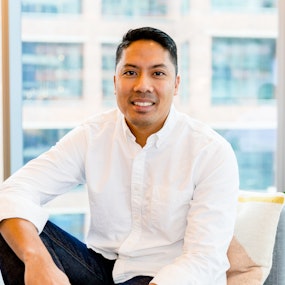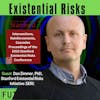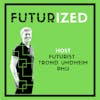The Future of Vertical Farming
Eddy Badrina, CEO of Eden Green, interviewed by host Trond Arne Undheim, futurist, investor, and author.
In this conversation, we talk about whether indoor grown food is equally healthy? How has the space of vertical farming emerged? We discuss the deman...
Eddy Badrina, CEO of Eden Green, interviewed by host Trond Arne Undheim, futurist, investor, and author.
In this conversation, we talk about whether indoor grown food is equally healthy? How has the space of vertical farming emerged? We discuss the demand for organic food, environmental concerns, soil quality depletion, groundwater depletion, and chemical pollution. Eddy explains the main distinctions and concepts, including Greenhouses, Hydroponics, Aeroponics, Aquaponic, Vertical farming, and the various growth vectors, such as greenhouse, shipping container, skyscraper, or warehouse. We discuss sensors, climate control, LED lighting. How do you define the vertical farming market? Who are the players? Which disruption forces are most actively influencing the field of vertical farming right now? How does he stay up to date? How does he recommend my listeners (and I) stay up to date? Looking at the next decade, I ask Eddy what he thinks will happen to vertical farming? We discuss high yield local food production in inner cities, near deserts, on islands, on in space and beyond
My takeaway is that vertical farming is poised for growth, and I don't just mean that as a pun. There are legitimate reasons why foodtech is exploding right now. Food and Ag coupled with tech is necessary, exciting, and is becoming scalable. Can the costs of vertical farming come down? Will we see vertical farms in every country and every municipality? Time will show.
Having listened to this episode, check out Eden Green as well as Eddy Badrina's online profile:
- Eden Green (@edengreentech): https://www.edengreen.com/
- Eddy Badrina (@eddybadrina): https://www.linkedin.com/in/eddybadrina
Thanks for listening. If you liked the show, subscribe at Futurized.org or in your preferred podcast player, and rate us with five stars.
If you like this topic, you may enjoy other episodes of Futurized, such as episode 87 Performance Food, episode 52 The Future of Peer-to-Peer, or episode 36 The Future of Cultured Meat.
Futurized—preparing YOU to deal with disruption.
Vertical Farming_mixdown
Trond Arne Undheim, Host: [00:00:00] Futurized goes beneath the trends to track the underlying forces of disruption in tech policy, as this models, social dynamics and the environment. I'm your host, Trond Arne Undheim, futurist and author. In episode 92 of the podcast, the topic is the future of vertical farming. Our guest is Eddie madrina, CEO of Eden green.
[00:00:24] In this conversation, we talk about weather. Indoor grown food is equally healthy. How has the space of vertical farming emerged? We discussed the demand for organic food, environmental concerns, soil quality, depletion, groundwater, depletion, and chemical pollution. Eddie explains the main distinctions and concepts, including greenhouses, hydroponics, aeroponics, aquaponics, vertical farming, and the various growth vectors such as greenhouse shipping containers, skyscrapers or warehouse.
[00:00:56] We discussed sensors, climate control, light-emitting Dios and led lighting. And how do you define the vertical farming market? Who are the players, which disruption forces are most actively the field of vertical farming right now? How does he stay up to date? How does he recommend my listeners? And I stay up to date looking at the next decade.
[00:01:18] I ask Eddie what he thinks would happen to vertical farming. We discussed high yield, local food production in inner cities nearby. Hazards on islands or in space and beyond Eddie. How are you today?
[00:01:32] Eddy Badrina, CEO, Eden Green (guest): [00:01:32] I'm doing well. How are you doing?
[00:01:34] Trond Arne Undheim, Host: [00:01:34] Yeah, I'm doing fine. I'm looking forward to talking agriculture.
[00:01:38]Eddy Badrina, CEO, Eden Green (guest): [00:01:38] I'm excited to be, to be talking with you.
[00:01:40] It's been a interesting, a busy past week and a half for me with our latest round of, of fundraising. So it's it's you're you're catching me right at the right time.
[00:01:52] Trond Arne Undheim, Host: [00:01:52] Well, let's talk more about all of those things Eddie. So, you know, you're. You're an interesting CEO of a vertical farming company.
[00:02:01] We, we, I think we covered that. You and I, in our little prep call, I wanted to maybe share that a little with our listeners. So you have a masters in public affairs and international affairs, and indeed you've been doing a lot of international work and a bachelor in psychology. And you shared with me that Texas a and M was the only techie part of your education.
[00:02:23] I mean the actual school itself, how at all, did this happened that you got into vertical farming?
[00:02:32] Eddy Badrina, CEO, Eden Green (guest): [00:02:32] Yeah, I'm, I'm a bit of an odd duck. And and I submitted admittedly. So I, I'm not your I'm not your typical when you go to college students and say, Hey, this is how you do a career. That is I, I'm not that person.
[00:02:45]So I, I got into it. A little bit of backstory. So a and M degree in psychology, like you said had a chance to go to the master's program there in public administration, international affairs. And that really that really sort of peaked my interest and and grew my love for all things, a macro strategy and and.
[00:03:06]Just from a geopolitical point of view, just a a worldview of that. So spent some time up in DC both at the state department as well as at the white house. And I got a good overview of the domestic and the international needs. And one of them that came up was just the, the ongoing struggle to have consistent food supply.
[00:03:28]I, I really, I addressed it from a domestic policy issue, but then when I came back to Texas, I went into the private sector and went into something totally different which was. A digital ad agency, a MarTech marketing technology company that I started in 2010 and started that from scratch, bootstrapped.
[00:03:46] It grew it to a size where he was able, we were able to be acquired in 2016 reacquired it from, from the company 11 months later. And then and then spun it back up. So all throughout those throws, you know, 15 years of career. I got a chance to I understand how to run organizations well understand how to, how to run a startup to be scrappy and not to be so corporate minded.
[00:04:15]And then, and then really, you know, understood the world of finance understood the world of investor relations and fundraising. And, and so that's where it brought me to this. I had a chance to step back from bud shift, which my, my marketing company and really take a look at what I wanted to do for the next, for the second half of my career, if you will.
[00:04:35] And and the three things that really stuck out to me were one, I wanted to do hardware software. I had done professional services. Been there done that. Got the MNA t-shirt. And so I wanted to do something different and apply my skills there. Second was, I wanted to have a level of impact on society in my community that was exponential to to my input.
[00:04:57] So for every one unit of input of effort that I put in, I wanted to have a 10 or 20 X societal impact. And then the third is I wanted to build, what's known as a redemptive organization and it's one where where the leaders eat last. They're sacrificial in nature. It's where employees are treated generously.
[00:05:16] Okay. And it's where the community and society around them is not just is not exploited. It's not even just advanced, but it's renewed and it's redeemed. And so you know, fortunately I was able to take a survey of with the companies out there and, and. Just had some colleagues and friends walk alongside me and eating green came up as a possibility in 2019 and became a reality and it checked all three of those boxes that I was looking for.
[00:05:43] And from their point of view, I checked the box of. He's I've run a startup. I've run it successfully. I know how to exit and I know how to how to take something to market, to find a product market fit and and find the right business model. So that's what I've been doing for the past year and a half.
[00:06:01] Is is taking this technology, which is patented but then getting out of the technology and really putting a business model around it that works that is scalable. That's attractive to additional investment and then to the market, obviously as well, and then taking it to market.
[00:06:19] Trond Arne Undheim, Host: [00:06:19] You know that that's, that's fine.
[00:06:20] Fantastic. Because vertical farming, right. It, maybe you can, since you've had a quick learning curve on, on this entire topic yourself, give me a sense of how the topic itself emerged. So that clearly there has been demand for. Food, you know local food and then there's the environmental concern, of course.
[00:06:39] And then there's the technology element in the fact that you, you kind of have to make it possible and then the scale, right? I mean, I'm sure that it was experimental for, for a while. And then, then obviously the increasing pollution can give me a sense of what are the factors that were the most important in creating this as a startup industry and, and now Arguably right.
[00:07:02] Coming to fruition as a scalable industry. What are the factors that made this emerge?
[00:07:08] Eddy Badrina, CEO, Eden Green (guest): [00:07:08] Yeah, so, so macro factors that have really contributed to to vertical farming and just enclosed what we call CA controlled environment agriculture. One is a rise in population and a trend towards urban areas.
[00:07:22] So when you have a rise in population and they're trending towards urban areas you run into a density problem, but the density in terms of population growth as well as density in terms of. Food sources in geographic relation to those population centers. So you've got less people out on, you know, on the perimeters, on the peripherals of urban the, the urban geography and and the farms are becoming further and further away from those population centers.
[00:07:51] So you've got this huge supply chain length. That that is, that is occurring in the, here in the United States. We're seeing it, you know, a lot of the lettuce and leafy greens come from the Salinas Valley in California, just because of its its climate as well as it's the, the richness of the soil there.
[00:08:11] But the reality is it's some, 2000 miles away from Texas and more twice that from the East coast. Right? Yeah. So you've got this long, long supply chain to really dense population. And then on the other piece from a, from a rise, you've got a rise in the demand for locally grown food. And you just got a rise in demand for healthy food, right.
[00:08:34] Nutritious food. And and that's not going away anytime soon. And the rise is not linear to the population growth. It's actually. Curving upward in relation to the population growth. So you've got those two factors that are going upwards. And then on the other end, in terms of the supply on, on the other end of the supply chain, you've got a decreasing or static supply of food, even if it were static in the best case circumstances static, you're trying to pipe it through this fragile and long supply chain.
[00:09:08] So, but in, in, in when the cases we're seeing you know, more internationally than domestically is got an erosion of topsoil, you've got unusable land due to pollution and just due to, you know, arable land. And so what you've got is this declining supply. And it's really regional and local in nature, right?
[00:09:28] If you're living 200 miles from Salinas Valley, you're golden, but if you're 2000 or 4,000 miles away from Salinas Valley, it doesn't really help. So there's these broad sweeping generalizations that you see on the news of, Oh, we have, we have this much supplies we need, we just can't get it to people or.
[00:09:47] We've got no supply and you know, it's, everyone's starving and it's somewhere in between. It's very a regional and local solution, which. You know, you've got a regional local solution that supply chain, and he's also got the regional and local demand for healthy sued. Yeah. Therein lies the solution. Right.
[00:10:07] So how have we solved for in the past, while we've suffered in the past by a flat tray, greenhouses, which you see they're all the rage today. Flat-rate greenhouses. As innovative as they want to call them. And they're still flat trays, which are about 20 years old. And those still require a lot of latent.
[00:10:24]And, and so you've got that problem. And then you've got the little, you know, the mom and pop community gardens. You've got the tower gardens and the patio things that you can stick on your patios. Those aren't really scalable to the folks who need it the most. It's not it's, it doesn't meet the demands of the general population.
[00:10:41]So neither, none of those have filled the gap until, you know, until now. And that's, that's, that's where we fit in and try to solve that problem. We we've got our greenhouses are dense enough. We're working in cubic feet because we're tiring up to 18 feet in the air, even sometimes more of these vertical towers.
[00:11:01] So we've got this density solved and because it's dense and it's because it's a one and a half acre footprint, then that can be put almost anywhere in the world, especially in urban populations.
[00:11:15] Trond Arne Undheim, Host: [00:11:15] You know, that's super interesting. You mentioned greenhouses and. It's almost it's perplexing to me that, that technology, at least in terms of it's just one layer structure has stayed, stayed that way.
[00:11:28] It's sort of surprising that this idea of farming vertically hasn't kind of taken off before, but, but in any case, What are some of the other distinct ways that the industry is trying to innovate in? So greenhouses, I'm sure there's innovation within the sector or greenhouses or within the concept, then there's hydroponics in it in and of itself, which, you know, growing with water aeroponics, I don't know too much about it.
[00:11:55]And, and, and then, so, and then you have the different growth vectors themselves and you you've. Pointed out greenhouse, but there's also shipping containers and warehouses. And so can you, can you line up the different factors that go into a decision on how to grow you know, how to farm?
[00:12:13] Eddy Badrina, CEO, Eden Green (guest): [00:12:13] Sure. So The the different, if you put a matrix of growing solutions, if you will, you've got your, you've got your traditional farms, right.
[00:12:23] And the pros to a traditional farm are you, the price per square foot of land is very low. Your, your economics look a lot better and you know, and, and it's a, and it's really down to a price deal. The cons are that amount of land. Has to be located far away from an urban center. The, also the cons are seasonality.
[00:12:45]The cons are external exposure to the elements, whether it's weather patterns, whether it's runoff from surrounding farms, whether it's the, you know, things in the air, any environmental, and then. Pests and everything that goes with them both the pests themselves, as well as the controls for them pesticides.
[00:13:03] So those are, those are some pretty heavy pros and cons. Hmm. So, you know, the, the next one on the wrong, if you will, is, are your flat Shay greenhouses in the flat tree? Greenhouses are, are, are less so economically than farms, but they're still pretty good. They're consistent. They are you know, they're enclosed.
[00:13:22] So they solve for some of the cons of a traditional farm. The cons of a flat tree greenhouse are that you still. From a from a density factor they're working in square feet and not cubic feet. So you still need quite a bit of land, which means they still need to be, you know, they can't be in the middle of the city because 35 acres of farming of traditional farms is equal roughly to about five to seven acres of your most innovative, flat tray, greenhouse.
[00:13:51] Right. And then and then because of seasonality you need a lot of lights. To beat for it to be commercially viable to, to have the same type and size and flavor profile of plants year round, you need complimentary lighting and complimentary lighting over five acres is a lot of CapEx. You know, it's there's one in, in in Kentucky called app harvest and 60 acre greenhouse size.
[00:14:19] They spent $15 million just on lights.
[00:14:22] Trond Arne Undheim, Host: [00:14:22] So, so just not to interrupt your flow here, but what about the Dutch and, and why have they, you know, in Europe, the situation in Northern Europe, at least the situation is slightly different because these greenhouses have been arguably perfected and, and the natural surroundings are, I guess, favorable so far.
[00:14:41] I guess I'm trying to, you really run out of land. So eventually this will also become necessary there, but they seem to have created over some time and expertise in, in, in the, what you call flat tray greenhouses. Is that over time going to go away or is it just a different situation there in Northern
[00:14:58] Eddy Badrina, CEO, Eden Green (guest): [00:14:58] Europe?
[00:14:59] It's a different situation because they have, like you said, they have the land and they're, they're set up in terms of their cities. Aren't nearly as big as our cities or as cities in Asia, right. Or as cities in Africa you know, you look at the top 10 cities around in terms of population. I don't think any one of them is in, is in Europe and it's not Northern.
[00:15:22] So it really is Geographically again, it's a, it's a regional problem and a local problem that requires local solutions. And for much of Northern Europe that has that solution has done just fine. And, and you're right. The Dutch and the French two have really perfected greenhouse technology. And that's, that's worked really well for them in greenhouses, have those flat tray, greenhouses that they've built and they run are, are very consistent.
[00:15:48]And they're seasoned agnostics. So there's, there's some great pros to that.
[00:15:53] Trond Arne Undheim, Host: [00:15:53] So it seems to me that here in the U S there's also another factor that surely you must be riding on right now. I I'm, I don't want to call it the Biden factor, but I mean, it's th th the fact that the U S seems to be somewhat waking up to this.
[00:16:07]You know, I don't know what you should call it, but this growing awareness that you know, things haven't been enormously sustainable all across right. Industry here and that there's opportunity. To change that actually fairly short term.
[00:16:21] Eddy Badrina, CEO, Eden Green (guest): [00:16:21] Yeah. Well, more than sustainability, I would call it food food security and food independence also.
[00:16:28] Right, right. I think, you know what we're seeing with the pandemic, what it accelerated in terms of trends is it accelerated the fragility of the supply chain and it accelerated the, the exposure of Certain certain groups of people not having access to nutritious foods. And you having runs on everything with the slightest, you know the slightest outbreak in you know, in bacteria, over in Salinas Valley or the slightest change in weather patterns.
[00:16:57] So I think that's what you're seeing and what the us is seeing and how, how that, you know, the response has been okay. In terms of infrastructure. And if, if you look at investments now you know, especially with the passage of this last set of laws, it's really focused on infrastructure. And one part of that infrastructure is is the food itself.
[00:17:17] It's not even supply chain, it's the food, right?
[00:17:22] Trond Arne Undheim, Host: [00:17:22] So. W w how did, how did your business then Capture this, the, this market and what, you know, what is your kind of claim to fame there? Is it the efficiency of the technology itself, or is it a sort of a combination of the concept? So the, the actual acreage and the optimization within this space, I mean, you have mastered a certain.
[00:17:46] you know, cubic footage, you have mastered the microclimate of a certain micro or you a certain square you know, cubic footage. It seems like that, that, that's what you're doing.
[00:17:56] Eddy Badrina, CEO, Eden Green (guest): [00:17:56] Yeah. You know, it's it's not that dissimilar to to a molecular structure in that it all starts with that small little micro climate that we have, and that we've patented the technology on if so, so.
[00:18:09] You know, in an, in a nutshell, this, this, the patent is around these vertical towers and how we control all the growing factors around each individual plants. So water flow, water temperature nutrient mix. The, the air CO2 air temperature light, right? And amount of light, as well as spectrum of light.
[00:18:32] All of those are factors that we control on this, on each end on the individual level of the plant. And so that, that comes into play because it's, it forces all sorts of efficiencies. Into the system, if you're only controlling for that microclimate. So imagine it's a good analogy is for air, at least imagine if you had in your house you had, instead of an HVAC system that controlled the entire house, you had your own personal AC and heating units, right?
[00:19:02]And use, it went around with you as on your, it was a backpack, if you will. So everywhere you went, the air was conditioned around. You. But everywhere else, the house could be 85 degrees and you would be just fine. Right? So, so then you look at the energy levels to control that. All of a sudden you've gone from trying to trying to condition the cubic feet of your entire house down to, you know, the six foot by two foot.
[00:19:28]You know, radius around yourself, right? Or diameter around yourself. That's a huge, huge amount of savings in terms of energy costs. Now. You get five of you? You know, if I had that in my household and I, I have a family of five, if we had five of us all together, sitting around the dinner table with our air conditioning units.
[00:19:48] Well, there's a, there's a, a byproduct of by, you know, a by-product effect of that, which is. That area around our dining tables, all of a sudden, you know, real conditioned relative to us because it's all adding together. Again, the rest of the house is still 85 degrees. That's essentially what we're doing in our greenhouses is we're conditioning.
[00:20:08]Roughly one fifth, we only condition one fifth of the greenhouse cubic. Space around those plant spots and then everything else is a happy byproduct of that conditioning. And if you're only conditioning one, one fifth of that cubic space, you're, you're it's not linear, but it is very, very similar to the amount of electricity costs, light electricity, air handling, all those.
[00:20:33]Inputs that you would have in a normal, either vertical farming, which is fully enclosed without sunlight or, or even a greenhouse, a flat tray, greenhouse.
[00:20:43] Trond Arne Undheim, Host: [00:20:43] I, I want to move shortly, I'll talk a little bit about the market itself, but, you know, as a, as a parlay to that discussion, what, what are the kinds of foods that.
[00:20:54] Lend themselves to be in grown this way. And, and what are the foods that perhaps are not going to be grown in vertical farming in the near future? Sure.
[00:21:05] Eddy Badrina, CEO, Eden Green (guest): [00:21:05] So John, you bring up a good point. I think a lot of folks look at us and others as the silver bullet for food and for nutritious foods. And, and I I'll be the first to say, we're not that we're going to be a part of the solution.
[00:21:20]We're not interested in growing grains. We're not interested in growing really Woody stemy type plants. Our, our ability to grow excels in the areas of leafy greens lettuce. Rugola spinach, kale and then, you know, and then herbs like mint Bazell time Rosemary and then onto things like strawberries, right?
[00:21:44]And then you've got your, your hemp and cannabis, which is a whole different story. But they grow very well in our system as well. But when you, when you look at that, Broad that, that spectrum of plants you're looking at around, I would say 50 plus varietals that are commercially viable. Now we can grow tomatoes and cucumbers and peppers all day long in our system.
[00:22:07]Peppers actually are profitable when you get the tomatoes and cucumbers in our system specifically from a commercially viable standpoint, I think it's we're still trying to. Tweak the system to make it so the volume and the price in the market matches up with the operating costs and the grow costs.
[00:22:25] Eddie,
[00:22:25]Trond Arne Undheim, Host: [00:22:25] I, I get excited when I hear these things just to not even just in terms of that, the global market situation, per se, but even just, if you think of it, It moving one of your units into a development situation where they have serious, serious drought or some other problem yet what they would have to have some stable electricity I'm assuming, or it is an energy source, you know, is that.
[00:22:52] Even in your scope at all. I know you, you want to change the world or are we talking here about just the American market
[00:22:58] Eddy Badrina, CEO, Eden Green (guest): [00:22:58] short term? No, I think our vision is to have, and again, I'm coming from a technology background, but our vision is to have a mesh network of these independently run greenhouses. That are, that are independently owned and operated, but they collaborate in terms of food supply in terms of technology, in terms of innovation.
[00:23:16] But I can, I can absolutely foresee these in you know, because they're, they're such great economic units. If you can imagine for a second. So one of the boards that I'm on a nonprofit board is called seed effect, and it does savings groups in microfinance, in refugee camps, in Northern Uganda. And, and if you look at these refugee camps nowadays, whether it's Northern Uganda or Jordan or anywhere else they are not the refugee camps that we are like have viewed in the past in that people are there for 10 to 20 years.
[00:23:51] Hmm. That's a long time and they have to create their own market economies in those refugee camps. And they're doing it just sheerly out of survival, right? So it was where seed effect is addressing from a savings group and from a you know a loan and finance perspective. I think there's room to have greenhouses eating green greenhouses in these refugee camps run by the refugees themselves, maybe owned by the UNH CR owned by USA ID.
[00:24:22] Some because. If you look at the costs and again, this is where my international experience comes into play. If you look at the costs per person in a refugee camp for the UN and the assorted agencies to support them per year, it's on the average, I want to say it around $110,000 per person that is not sustainable Chon.
[00:24:45] It's just not for, for the global. Community. So there's gotta be better ways knowing the parameters in place they're going to be there. You know, an external factors out of our control. Why they're there in the first place? How can we solve for that in a much more cost efficient manner? And the solve is to empower them to grow their own food, to employ themselves.
[00:25:09]And then to distribute that, I mean, I would much rather UN and donor money go towards a greenhouse that can be built and subsidize the entire output of that. Th that would be much more cost efficient than, than. This current support structure that's in place for those refugees. So that's just one example,
[00:25:30] Trond Arne Undheim, Host: [00:25:30] right?
[00:25:30] Yeah. Yeah, no, I mean, I just got so fascinated by thinking about the, the, the longterm kind of application of your concept as you're sort of productizing it, but, but even, even in the U S right the market seems to be growing and the various studies out there, but certainly one study I saw from the emerge and was saying, you know, 11.
[00:25:49] Billion dollar market by 2027, which is not very far away. It's nice and glowing and growing at a, at a 20% even what are some of the challenges, the market, the players, cause there's, you know, there's obviously more, more than you out there and they have various models. So AeroFarms, bright farms, all these guys W what I mean, traditionally the high upfront costs, which, I mean, you were pointing to the UN example.
[00:26:15] Somebody has to say, Hey, I'm, you know, I'm footing that first bill.
[00:26:21] Eddy Badrina, CEO, Eden Green (guest): [00:26:21] Right. Right. So, so there, there are a couple of big challenges. One is yeah, you got it right. The CapEx, the capital expenditures on the upfront. Yeah. And, and the other is the operational expenditures. But what really, those are functions of our Are the costs to the consumer and current models right now.
[00:26:40]They're being basically being subsidized to sell it to the consumers. I mean, they're, they're losing money on every clamshell, plastic clamshell that they ship out the door. Most of these most of these other You know, competitors because their cap ex and their OPEX are so high. And, and so that's been, the biggest challenge is how do you get something that's at a price point that makes sense to the consumer.
[00:27:04] Right. And, and I would say that is the biggest challenge. The biggest challenge is, is operational and capital expenditures to get it to a price point. That makes sense because the market will only bear a certain price point for lettuce will only bear a certain price point for Bazell and for rubella and for kale.
[00:27:22] So to get those efficiencies down is, is a big challenge. And that's where I think, you know, the, the founders of this company who you know, who are Respectively our, our CTO and our COO jock and Eugene vendor. And they, they had to start in South Africa from scratch. They literally started in their garage.
[00:27:41] And so when you're in South Africa and you're starting from scratch, you're not building with. Tons of money being thrown your way. You have to do it in a scrappy manner and you have to build it from scratch, thinking about economic, economic profitability. And so I think that's the biggest difference with us is our greenhouse units.
[00:27:59] If you, if you can sell all that off, take all of that, that harvest in, in the in, in the industry, it's known as offtake contracts, but if you can sell all of that harvest, those greenhouse units are. Economically profitable. Their, their gross margins are, you know, anywhere from 35 to 40%. That is a far cry from a lot of the other folks out there who are have.
[00:28:23] A hundred, 200, $300 million of funding. And they're just burning through cash cause they, they are figuring out the technology first and then and then trying to determine economic modeling later. Whereas in our case we did that hand in hand, so we knew we had to know going into it. The brothers had to know going into it, that it would be economically sustainable.
[00:28:44] Hmm.
[00:28:45] Trond Arne Undheim, Host: [00:28:45] I'm curious about some of the other disruptive factors that are working in your favor or are a bit challenging. So on the regulatory front, are there any challenges there or any opportunities for, for getting this subsidized under some sort of scheme?
[00:29:00] Eddy Badrina, CEO, Eden Green (guest): [00:29:00] Yeah. So, you know, the, the challenges really is education and this, this industry is so new.
[00:29:06] And then what we're doing is new within the new industry that I think regulators are just having a hard time getting their hands around it. And when I say regulators, I mean, local local agencies. And you know, they, they look at us and like, wait, So you're you're an acre and a half large, but your water out to you know, your water consumption is equal to two households.
[00:29:28] That's it? One of our acre and a half greenhouse only consumes 90,000 gallons of water a year, your house. And then my household consumed 45,000 gallons of water, a piece, right. To, to produce 50 tons of leafy greens. I mean that, that boggles their mind. It's almost too good to be true for them. So then, you know, then they try to, you can't put it in your normal industrial or agric, you know, agricultural model in terms of in terms of how you how you regulate the land, right?
[00:30:02] How you permit all the permits and regulations. So there really is a learning curve on, on local agencies and local permitting on how, how our how efficient our greenhouses are. And then I would say, you know, the other biggest challenges when it's in our favor, like you said, but. Agriculture is, is not just the supply chain, but the actual production is now considered infrastructure.
[00:30:27] If we think about the more and more the demand is that everyone have access to nutritious foods. The more that'll go from from Commercial to infrastructure. And that plays right into where we are, because we are really an we're a greenhouse as a model. We're an infrastructure play. We put ourselves, you know, from an ESG type investment, we put ourselves right there with wind and solar in terms of just how how cutting edge.
[00:30:54] There's still a lot of kinks to be worked out in the regulatory and in the industry. But we really think that's where it's headed longterm. You know,
[00:31:02] Trond Arne Undheim, Host: [00:31:02] it's interesting. I don't know. I keep getting all these strange ideas when I listened to you, but it seems to me that they're going to call you when we go to Mars and the moon, right.
[00:31:13] You're going to have to feed people there in, in a, in a constrained environment. I mean, controlling all the variables sounds like up your alley.
[00:31:22] Eddy Badrina, CEO, Eden Green (guest): [00:31:22] Yeah. Yeah. It's controlling all the variables, including size and density is, is really where we Excel. Right. And you know, and again, we're, if, if there are countries that are constrained by water but they're not constrained by land then, you know, it's, we, we don't compete as well as you know, flat tray greenhouses.
[00:31:47]But, but if man, if they are. Density constraint in terms of population their demand consumer demand is for locally grown food and they have real water issues. W we, we play right, right into that.
[00:32:00] Trond Arne Undheim, Host: [00:32:00] How do you work around deserts? I was reading about the mounts, the Sinai desert project, where people are trying to see if they can, you know, re re green that entire desert and, and make it a new type of ecosystem.
[00:32:13] I mean, I would just imagine that. You know, long-term, as a, as an infrastructure play, this, this model would, would really go very well around deserts.
[00:32:22] Eddy Badrina, CEO, Eden Green (guest): [00:32:22] It, it does you know, for, for the deserts that are that are like Israel, Israel is a good example of a landlock. A very arid type of environment, right.
[00:32:34] They don't have a lot of arable land. It's very Rocky, right. Unless you're by by the coast. And so there's just not a lot of usable land. So ours, our solution works really, really well. And then on the other hand, you have, you know, call it a Saudi Arabia. They have tons of land. Th they don't, you know, the density factor is not that concerning to them in as much as it's as it's food independence, and as much as it's a water conservation and we can play in those arenas, but you know, candidly I look at them and I think, wow You know, you're probably for, at least for the next 10 or 15 years, you may be good to go with a flat Sheree greenhouse.
[00:33:16] It's not going to be nearly as efficient and you're going to have you're going to have water problems for sure. But in terms of land usage, that's not really their concern. So I do think as water costs start to go up and water scarcity becomes more of an issue. Things like ours will come into play, not from a density per se.
[00:33:35] The density is. A feature, a function of it, but it's really from water usage and where it's not a concern right now. It will be a concern in, in, you know, 10 or 15 years.
[00:33:46] Trond Arne Undheim, Host: [00:33:46] Let's just talk some mechanics here. So you, I, and I'm reading some old data I'm sure. But on a 1.5 acres site, this article claims that you could produce 900,000 leafy greens in a year and habit between 11 and 15 harvests that this would take 33 acres.
[00:34:05] So traditional farm land, and then using 98% less water. I mean, the number of harvests is sort of staggering.
[00:34:13] Eddy Badrina, CEO, Eden Green (guest): [00:34:13] It's phenomenal. It's phenomenal. And it goes back to that microclimate. Right? So the way we're able to do that, that amount of harvest is, is simply simple, but it's it's not easily solvable it's simply because when you control for all the factors and you give the plant exactly what it needs when it needs it, in terms of light, water and nutrients and then the ambient temperature, they grow quickly.
[00:34:37] I mean, they grow very, very quickly. And so the average depending on the leafy green, the average sorry, harvest cycles is anywhere from 2028 to 35 days, which is where you're getting your 11 to 13 harvests a year. And because it only takes a day or two for us to turn it around, take the plant out, clean out the, clean, out the cup, and then and then plant the new seeds or the new seedlings in.
[00:34:59] So that's, that's where, that's how we're able to do it. And these plants, I mean, they thrive you know, the, even there's so many aspects to it, but plants love a certain temperature, you know, 75 to 85 degrees, depending on the plant, but even more. So plants love 67 to 70 degree water. It allows for the maximum amount of nutritional uptake as well as it reduces the amount of pathogens because of the aeration of the water.
[00:35:30]And then the flow that we have in one of our greenhouses, from pump to plant, to pump in an acre and a half takes all of 90 seconds.
[00:35:40] Trond Arne Undheim, Host: [00:35:40] Look, I'm, I'm learning a lot here. Look, I'm a, I'm a hobby gardener myself. I have my own little kind of enclosed to garden with the, you know, it's all enclosed metal fencing to try to get some critters out.
[00:35:52] And I'm struggling, man, because this is tough. Right? So you got critters, you're fighting. And then last year I got most of the critters out, although like a couple, you know, got in, but essentially got out all the big critters. So at least, you know, all my fruit wasn't just taken by the squirrels.
[00:36:08] Right. But, but I had pest problems. Yeah. And then last year I decided to go all organic and probably wasn't smart enough. Didn't find the right products and probably didn't have enough time, but I lost a lot of my harvest. And for, for, you know, w what, what have you learned, or what does this system teach the everyday gardener?
[00:36:27] Is there anything. To learn. I mean, I was picking up the temperature that I should be watering my plants if I could, but we don't have all those tools available. But what are some like quick fix things that one can do as a hobby gardener to try to isolate some more factors you know, then the than is available in the wild, because it seems to me there, I mean, I'm scratching my head at a, some of the things that are happening because, you know, I grew up in Europe and Norway and nature here doesn't behave the same way.
[00:36:52] I'm also forced to believe that some of the plants are, are actually kind of conditioned to, to being you know, they're conditioned to pesticides actually. And when you don't give it, give that to them, they, they don't really seem to handle it. Right. Well, so I have lots of
[00:37:07] Eddy Badrina, CEO, Eden Green (guest): [00:37:07] questions. Yeah. You know, those are.
[00:37:10] There's a lot of the, the, the intricate questions are probably best left to my agronomist in greenhouse manager then to me. But, but I, I can't, so one of the things that you're highlighting is people often ask, well, why can't everyone do this? And, and you highlighted just the fact, like all of those control factors and then trying to meet.
[00:37:29] Very picky consumer and retailer demands is just a tall, tall task. And so that's why commercial scalability has been such an issue at CA at scale as well as the cost to do that has been such an issue for the industry in the past. But then, you know, getting down to your, to your specific questions, I think You know, the best thing people can do is honestly, is to build little greenhouses and also to set your expectations, right?
[00:37:56] Like we were able to do 11 to 13 harvests a year cause we have complimentary grow lights. In addition to our sunlight's Mo most people don't have grow lights. Right. Should I go into, on the lights? I mean this it'll get really expensive really quickly. I'll tell you that. Especially if you've got to, you know, to, to try to shrink this down, like, if you can imagine that, and I'm just, you know,
[00:38:21] Trond Arne Undheim, Host: [00:38:21] my neighbors probably wouldn't like it either because yeah, exactly.
[00:38:24] Show up
[00:38:24] Eddy Badrina, CEO, Eden Green (guest): [00:38:24] everywhere. I'm just spit balling here. But you know, if you had a greenhouse and you put it, you put a set of grow lights on top of it. And then, you know, and then you used your organic pesticides. Pest control techniques within that greenhouse. I think that would, that would probably do the trick more so than having an exposed just to the elements and more so than just, you know, using, using your current pesticides without any other control factors.
[00:38:51] You really start to, once you start going down that rabbit hole, you really start to understand how many control factor, how many factors you have to control to really optimize for harvest. And then. Okay. A corollary to what you said, plants know when it's winter. It's crazy. It's crazy. Like we've got, you know, we've got sunlight, full sunlight, we've got the grill lights, all, you know just honed in with, you know, with our, with our algorithms and with our control systems.
[00:39:19] And yet. The plants in the winter tend to be a tiny bit smaller than the plants in the summer. They just know it's winter. It's bizarre. But, but I think it, you know, it speaks to it speaks to the fact that at the end of the day, you can't really control everything. We're just trying to control as much as possible.
[00:39:39] Trond Arne Undheim, Host: [00:39:39] I wanted to get to this scale and kind of your, your vision for, for becoming a, a little bit of an Intel inside for, for large. Social units, essentially that need to produce whether it's universities or nation States or large organizations. I mean, currently I'm assuming you're selling to retail or you're at least aspiring to sell to very, very big retail chains that are kind of that's correct.
[00:40:04] Have enormous demand, but you sort of, you, you alluded to me that there's another interesting market here that I just didn't really think of that to, but of course, if you're a municipality or. Or even a nation state, like let's, let's call it Israel or whatever it is. This is interesting. If it really is an infrastructure where you can control the supply of food against pandemics and climate changes and all kinds of X factors that happens in regular agriculture.
[00:40:35] Eddy Badrina, CEO, Eden Green (guest): [00:40:35] Yeah. You know, if you if you take food subsidies to their logical end, you end up with. Government funded food sources in their entirety. Right. And so it's the, the leap from food subsidies, to farmers, to grants and subsidies for operators or owners to these greenhouses to produce them to then the government just owning them themselves or the municipalities, right.
[00:41:05] Municipalities and regionals authorities owning them. The cells there. It's not that big of a jump. So w we think we can address all of those. You know, it's a, it's a, it's a dynamic market. Regionally, some, some authorities really want resiliency. They want regional and city resiliency. Other ones are very free market.
[00:41:24]We, we think we can play in, in that entire gradient.
[00:41:29] Trond Arne Undheim, Host: [00:41:29] Take us take us to the future because we've talked a lot and I thought it was important to get the context about what this really is. And I really wanted to go deep into how you are doing things to the extent that you could share with us, but in the next 10 years or, or even, you know I'm thinking increasingly looking longer term, I have a big project looking at the next 50 years, but.
[00:41:50] Even just the next 10, you said it's not a silver bullet. It's not the only answer, but it is a answer to local nutritious food in certain segments of the world. So it was a society in the world. W where is this gonna? And what, what percentage of food is going to be kind of artificially grown in some format in the next 10 days, 10 years?
[00:42:15]Eddy Badrina, CEO, Eden Green (guest): [00:42:15] In the next 10 years, I would say, you know, it sounds really small, but I would say anywhere from you know, 3% to 5% of all food grown will be, you know, we'll be in these type of controlled environment. Ag agricultural systems doesn't sound like a lot, but that's, that's. That's a huge amount of pressure.
[00:42:35] Oh, I
[00:42:35] Trond Arne Undheim, Host: [00:42:35] think it sounds enormous. I mean, it just depends what the, you know, what the total
[00:42:40] Eddy Badrina, CEO, Eden Green (guest): [00:42:40] is of course. And, you know, and, and the number of fruit for eating green, our vision is that there would be one of these in every country in the world. You know, I don't, I don't think it's, I don't think it's beyond beyond scope to think that, you know, 162 of these would be placed in in different countries.
[00:42:58] If you think about Island, Island, economics these, these belong as well, you know on a on on one of the Island, Pacific Island nations, as they do. You know, in, in Dallas, Texas for all sorts of reasons, they have supply chain issues that we can't even fathom. I was just curious, have you,
[00:43:14] Trond Arne Undheim, Host: [00:43:14] have you mapped the world according to who would have the biggest need?
[00:43:19] Cause I mean, you know, if we're just thinking deserts, we're thinking water, well, any, any water scarce area, right. Islands, because of the supply issues, you know, and, and just being islands, what are some other things that would, would come out when you do that kind of analysis?
[00:43:35]Eddy Badrina, CEO, Eden Green (guest): [00:43:35] So so population dense.
[00:43:38] So you take the top largest, you know, 20 largest cities in the world. Those are all viable opportunities for one of our greenhouses to be in like he's, like I said before, landlocked States, land landlocked nation States that are looking for food independence. And food security are, are others
[00:43:54] Trond Arne Undheim, Host: [00:43:54] Northern States, I'm assuming.
[00:43:56] Right. So I grew up in Norway. I mean, certainly, you know, without greenhouses in the North of Europe or Canada or Alaska, you can't grow much.
[00:44:06] Eddy Badrina, CEO, Eden Green (guest): [00:44:06] Yeah. Yeah. The, the I think that those are the seasonality conflicting with consumer demand for year round food. And year round produce those are, those are other places, right?
[00:44:17] So so the, the Northern climates are where those conflicts happen the most where consumer consumer trends buck up against a buck up against the season. And then, you know honestly there's a whole, we'll play around here in the United States around native American. Tribes in their sovereignty, right.
[00:44:36] They they've got their own reservations and sovereign sovereign systems that they're trying to solve for their people. So I mean, the. That's what I, that's what I'm really excited about. Our PR our platform in particular, it's so nimble and flexible that can, it can be applied to a vast variety of situational needs depending whether it's food independence, whether it's scarcity, whether it's water shortages, whether it's just consumer trends and demands.
[00:45:05]The, the flexibility of our system allows to address all of those.
[00:45:09]Trond Arne Undheim, Host: [00:45:09] I, I, you're probably not going to give me prices here, but like, you know, what, what is the payback time on, on investing in a unit like this? If you are an Island or a country or any of these things that, you know, these entities we have been talking about?
[00:45:22] I mean, what is the payback time? Like when, how soon are you going to see a profit? Let's say you have the you know, the CapEx. Yeah. And you might be
[00:45:32] Eddy Badrina, CEO, Eden Green (guest): [00:45:32] interested in this. Right. So if you're selling the entire off-take of the greenhouse, the con the harvest payback's around four to six. Hmm.
[00:45:44] Trond Arne Undheim, Host: [00:45:44] Yeah. So population growth is high, right.
[00:45:47] And I was asking you so 10 years, but what if we go 50 years into the future, and I don't know what's going to happen to population growth, but one couldn't at least assume that it, you know, it certainly won't be much lower than, than it is now. In that short of a timeframe.
[00:46:03] Eddy Badrina, CEO, Eden Green (guest): [00:46:03] Yeah. I think the pandemic, the pandemic has provided, I think this is very futuristic.
[00:46:08] I think the pandemic is a blip in the population growth. We've seen some just because of people's isolation and inability to socialize. You've seen a little bit of a dip in terms of the reproduction rates as, as, as predicted for this past year. And then, you know, and then in terms of people.
[00:46:26]Moving to urban population centers. I think it's slowed during the pandemic because people had to stay home and because at least here in the United States, you found more ability to work remotely. But I think at the end of the day, people are still gonna move towards towards urban populations.
[00:46:42] And, and I don't think that'll slow down. I think we're gonna pick back up. So if you, if you take those two trends, population growth, and then and then the magnetism towards urban population centers. I think I think you're going to see more of these and then, and then the consumer demand continuing to grow for locally locally sourced and nutritious foods.
[00:47:02]I think you'll see the demand for these to be the center of gravity to be around those those large urban population.
[00:47:11] Trond Arne Undheim, Host: [00:47:11] Interesting. Well, If people want to get into this and want to understand more or want to track your space. So the vertical farming market, what are some of your best bets to, to start tracking?
[00:47:25] You know, who are the influencers you know, apart from them individually, apart from companies like yours, who is looking into this space and who, how would you, how do you stay up to date?
[00:47:35]Eddy Badrina, CEO, Eden Green (guest): [00:47:35] So I stay up to date just reading things like vertical farm daily or Horta daily is one, but then also for your, for your normal consumer of information, you know, I would look just start looking at ESG investments.
[00:47:51]And, and their patterns and trends of the ESG investors where they're looking at, you'll get a good sense of what, how people are thinking about this space in general. I think, you know, you, you look to some of the bigger foundations, the Gates foundation. The Rockefeller Ford foundation and then the UN you look to see where their minds are at in terms of addressing population growth and addressing water water scarcity.
[00:48:19]I think you'll, you'll, those are, those are good places to start. But yeah, I. That's where that's where I would begin. And then, and then we're, we're trying to educate a lot. It's one of one of the directives I've had to our marketing team is to really educate folks on what are, what is hygiene like?
[00:48:35] W just what's the hydroponics one Oh one, right? What's vertical farming. Why is vertical farming? You know, the future, what is just some of the basic education pieces? Not to just get over the hump of understanding eating green, but just to get, get people a better context for why we're doing what we're doing and the problem we're trying to solve, because I don't think a lot of people even realize the problem exists.
[00:48:57]They're in their happy little bubble until until their local, you know, Chick-fil-A or you know, or, or whole foods runs out of. Romaine lettuce. And then they start looking around saying, what is the problem? Right. So so we want to educate folks and, and, and so we're, we're producing more education content on eating green.com.
[00:49:16] Trond Arne Undheim, Host: [00:49:16] Well, that's certainly quite useful. I find I find the topic interesting and futuristic, but obviously it's happening now. It's not like very vertical farming is not tomorrow. It's you guys are rolling it out. You're not alone. And It's a, it's going to be a part of the food picture.
[00:49:34] Eddy Badrina, CEO, Eden Green (guest): [00:49:34] Absolutely.
[00:49:35] Trond Arne Undheim, Host: [00:49:35] Absolutely. Well, I thank you so much for sharing your, your views. And I hope we can stay in touch because I imagine that you guys will spread your tentacles a bit, and it would be interesting to check back in and see who's buying into this because it could go in all kinds of directions. So I'm I'm of,
[00:49:52] Eddy Badrina, CEO, Eden Green (guest): [00:49:52] I would love to, I would love to have a conversation six months.
[00:49:56]Or, or a year from now. And and look back and say, man, we, we were just scratching the surface in this conversation of of what happened or what could happen. So look forward to staying in touch.
[00:50:08] Trond Arne Undheim, Host: [00:50:08] Very good. Well, thanks for being on the show. All right. Thank you. You have just listened to episode 92 of the futurizing podcast with host futurist and author topic was the future of vertical farming.
[00:50:23] And this conversation we talked about, whether indoor grown food is equally healthy. How has the space of vertical farming emerged looking at the next decade? I asked Eddie what he thinks will happen to vertical farming. My takeaway is that vertical farming. Is poised for growth. And I don't just mean that as a pun, there are legitimate reasons why food tech is exploding right now.
[00:50:48] Food and ag, coupled with tech is necessary exciting and is becoming scalable. Can the costs of vertical farming come down, we will see vertical farms. Will we see vertical farms in every country and every municipality time will show. Thanks for listening. If you liked the show. Subscribe at future, I start org or in your preferred podcast player and rate us with five stars.
[00:51:14] If you like this topic, you may enjoy other episodes of futurizing such as episode 87 in performance food episode 52, the future of peer to peer or episode 36 on the future of cultured meat. Future prepare you to deal with the disruption.

Eddy Badrina
CEO
Eddy Badrina is the Chief Executive Officer of Eden Green. Over the past 20 years, his career has encompassed entrepreneurial, corporate, and government roles. Prior to that, Eddy had mission-critical roles at the US Department of State, executive leadership at a White House Initiative, and director level positions at two successful startups. In 2019, Eddy took over as CEO of Eden Green, which, through its vertical farming technology stack, is changing the way we farm our produce, and feed our communities. Since then, retailers, researchers, and governments have discovered how Eden Green's technology can help them establish food safety, food independence, and sustainable farming unlike any previous ag tech solution. He was co-founder of BuzzShift, a digital strategy agency for mid-sized brands and organizations. Eddy and his co-founder had the unique opportunity to sell BuzzShift in 2016, reacquire it, and sell it again in 2021. Eddy has an MPSA degree in Public administration and international affairs and a BS in Psychology from Texas A&M University.
New to Futurized podcast?
Here are some great episodes to start with. Or, check out episodes by topic.















































